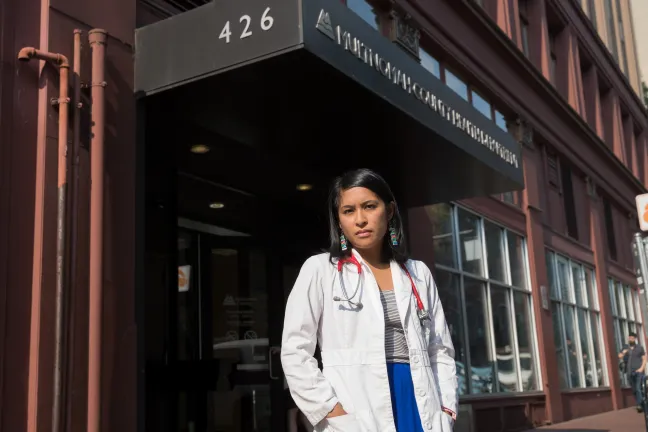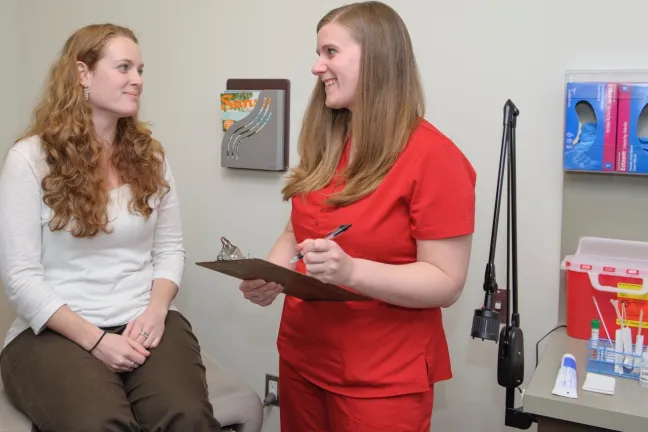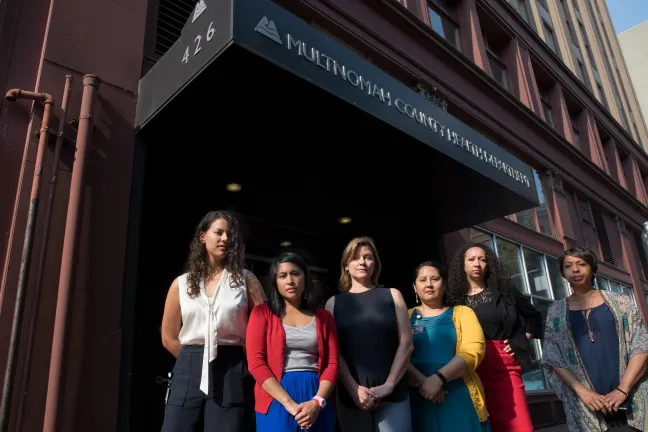Across Multnomah County’s network of health clinics, more than 6,000 women receive contraception, testing for sexually transmitted infections, and pelvic and breast exams due to support from a federal family planning grant called Title X. Those appointments also serve as a check on blood pressure, a chance to update immunizations, and an opportunity to talk about safe and healthy relationships.
Title X funds have targeted a health disparity between white women and low-income women of color — those most likely to experience unintended pregnancies and health complications from a lack of access to reproductive care and systemic racism. In Multnomah County, that means 97 percent of clients served by Title X are either uninsured or rely on public insurance. Forty percent of clients are Latina, and an additional 14 percent are African American.
Over the past two decades, the program has helped cut pregnancy and abortion rates in Multnomah County by more than half. The program directly prevents more than 1,000 unintended pregnancies a year in the county; about half of which would, statistically, end in abortion.
But proposed changes to the federal program could endanger those outcomes, nurses and doctors across the county now fear, by not only forbidding providers from discussing abortion as a legal option but also banning them from giving any information whatsoever, even for unrelated services, about clinics that perform abortions.
Those changes would affect facilities such as OHSU’s Center for Women’s Health. They also threaten to gut Planned Parenthood, the nation’s most well-known abortion provider, by adding complicated new bureaucratic requirements. Planned Parenthood, beyond providing abortions, also operates a clinic system that provides contraception and preventative care to 40 percent of the nation’s low-income women. Officials would have to completely separate the two services under the proposed rules.
“Abortion rates go down when there are fewer unintended pregnancies, and there are fewer unintended pregnancies when there is better access to contraceptives and better sex ed,” said Aileen Duldulao, PhD, maternal and child health epidemiologist for the Multnomah County Health Department.
About half of all pregnancies in the United States are unplanned. About half of those occur when a woman isn’t using any form of birth control; the other half occur when contraceptives fail. Low-income women are twice as likely as high-income women to have an unintended pregnancy. And low-income women of color experience both the highest rates of unplanned pregnancies and also the highest rates of infant mortality.
But access to family planning that includes information about abortion services actually lowers the rate of infant deaths; in fact, between 1980 and 2010, the infant mortality rate was cut in half, nationally correlated to a doubling of state funds for family planning.
“Because fewer women in our community may be able to access care at important safety net clinics funded by Title X, other clinics and hospitals may see larger volumes of women with higher levels of illness,” said Dr. Maria Rodriguez, medical director of the Reproductive Health Program at the Oregon Health Authority and an associate professor of Obstetrics and Gynecology at OHSU. “These cases are likely to require more complicated reproductive care, which could have been prevented with earlier access to Title X funded services.”
Congress enacted Title X in 1970 to provide low-income and adolescent patients with preventative family planning services. It sought to help women decide whether and when to have children by promoting access to birth control, education and preventative healthcare. Providers receiving grants were prohibited from using Title X funds to help clients terminate a pregnancy, but clinicians could discuss a woman’s option for abortions and refer them to licensed and safe clinics that performed abortions.
Then, in 1988, President Ronald Reagan added a section to the act, prohibiting clinicians from using Title X funds to counsel women on abortion or referring women to abortion providers. Providers weren’t allowed to explain consent forms, schedule an appointment for, or coordinate transportation to, an abortion provider. The new section banned grant recipients from lobbying for continued access to abortion or taking legal action to protect women’s right to choose.
“It came off as being a gag order,” said Dr. Marty Grasmeder, medical director of Multnomah County’s Integrated Clinical Services. He was still a resident, serving low-income women in the Portland area, when the funding rules changed. And he said the rules limited his ability to serve his patients.
“The Supreme Court had already ruled that it was a woman's right to decide what to do with her body. And this was a way to curtail that right. We were providing substandard care,” he said. “It’s not morally justifiable.”
Five years later, President Bill Clinton suspended Reagan’s gag rule by presidential memorandum. When the reversal was made final in 2000, the rules also included a requirement that grant recipients counsel women with unintended pregnancies about their legal rights to an abortion.
But this spring the Trump Administration, which vowed to curtail access to abortions, proposed reinstating Reagan’s 1988 rules, arguing that providers shouldn’t be forced to disclose a woman’s right to have an abortion if it is inconsistent with their religious beliefs.
The administration also argues that the current language doesn’t go far enough to disassociate federal funding from abortion services.
For example, Planned Parenthood uses Title X dollars to provide low-income women with contraception and preventative health care. They use other funds to provide women with access to safe and legal abortions. The proposed rules would require grant recipients to fully divide their family planning and abortion services, with separate facilities, personnel, and records.
Also under the proposed rules, a doctor would be permitted to provide counseling on abortion “only if a woman who is currently pregnant clearly states that she has already decided to have an abortion.” And all other patients who experience an unplanned pregnancy would be provided a list of providers “who do not provide abortion as a part of their services,” along with referrals for prenatal care and social services.
“Under the proposed gag rule, we would be limited in the type of counseling we could provide,” said Charlene Maxwell, Deputy Nurse Practitioner Director and reproductive health coordinator for Multnomah County.
When a woman is faced with an unplanned pregnancy, a nurse or doctor will walk her through the options — she may want to parent the child, offer the child for adoption or terminate the pregnancy.
“It is in no way directive,” Maxwell said. “If, after that, a client wants to pursue an abortion, we offer the phone numbers to abortion providers.” Usually that’s Planned Parenthood, the Lovejoy Clinic or OHSU.
What’s called “options counseling” is a small part of the services funded by Title X; of the 4,566 pregnancy tests County clinicians performed in 2016, 310 were positive. Of the more than 6,000 women served in Multnomah County using Title X dollars in 2016, just 4 percent sought options counseling for unplanned pregnancies and 26 women were referred to an abortion provider, according to data compiled for the Oregon Health Authority.
During that same time, clinicians performed more than 3,000 gonorrhea tests, more than 2,700 pelvic exams and nearly 2,000 pap tests. They made more than 100 social service referrals and administered more than 500 vaccines. But most women come in to talk about protection.
“Contraception, that’s the biggest piece,” Maxwell said. “But also cervical cancer screenings, well-woman checks. Because we’re providing this in the scope of a family practice, we’re looking at mental health, heart health, the entire body.”
While options counseling is a relatively rare duty for county clinicians, it tells a client that her doctors are being transparent. Losing the ability to talk about all of a woman’s options puts clinicians at risk of losing that trust — and the ability to continue providing all of those other important, life-saving services.
“Cutting off information about medically safe and appropriate care for some women puts you in a position of not being a trustworthy provider,” said Dr. Lindsay Braun, a provider at the East County Health Center. “If you’ve got any restrictions on what a provider is able to talk about with a patient, it sets a dangerous tone. It would put me in a position — forcing me to make a choice between suffering the legal consequences to best serve my patients, or coming to terms with not providing care that I think is appropriate.”
Nurse Practitioner Kristin Case said gagging providers from sharing a full rage of legal and safe options would hurt the most vulnerable, especially teens. “I have seen people in their lives coerce them into making decisions about their bodies and their futures,” she said. “It’s my ethical obligation to provide balanced and unbiased information.”
Nurse Sarah Jayne said she would have to question the profession, if she was forced to censor her discussions with patients. “I don’t know if I could still work in the field, honestly,” she said. “I can’t even fathom not being able to give accurate information about a woman’s legal options. It’s like lying by omission.”
Clinicians in Multnomah County are in good company. Among the professional organizations that oppose the changes to Title X are the American Medical Association, the American College of Obstetricians and Gynecologists, the American College of Physicians, the National Association of Nurse Practitioners in Women’s Health, and the American Academy of Pediatrics.
They are also joined by outrage from their own leadership.
“When did it become OK to withhold scientific, unbiased medical advice and data from women?” Commissioner Lori Stegmann said.
“As a woman and a mother, it’s fundamental that all women have the autonomy to make decisions for their healthcare with the counsel and support of their doctor,” Commissioner Jessica Vega Pederson said.
“Government has no business censoring doctors from giving complete and accurate medical information to their patients, regardless of whether they’re talking about diabetes or reproductive health,” Multnomah County Chair Deborah Kafoury said.
Oregon Gov. Kate Brown last week pledged to pull Oregon out of the federal Title X grant, which provides about $3 million a year to the Oregon Health Authority for distribution to clinics serving low-income women. The state would then have to find a way to provide that funding on its own, but would be freed from having to mind any new federal restrictions.
Kalpana Krishnamurthy, policy director for the advocacy group Forward Together, said Brown’s move shows leadership, and that she’s sure Oregonians will support preserving the services if Oregon opts out. “If we need to find additional resources, I hope the Legislature is ready to take this up, she said. “Voters are with us on this; they understand healthcare is something every Oregon family needs."
Meanwhile the Oregon Health Authority has cautioned grant recipients that there’s little to do now but wait and see whether the proposed rules take effect. The federal government must respond to thousands of public comments before it makes any changes final. And a legal challenge is likely.
But if Title X does change, Helene Rimberg, section manager of Adolescent, Genetics and Reproductive Health at OHA, warned grant recipients in a letter last week that “adherence to the new rule would have devastating effects on the quality of reproductive care.”
Health Department leadership has countered with a reassurance to its team.
"We're grateful for backing from our Community Health Council Board, County Commissioners, and a pledge of support from our governor,” said Health Department Co-Director Vanetta Abdellatif. “I want to assure clinicians that we will work with our board and the state to make sure all women have the information they need to make the best decisions for themselves and their families — and that’s medical care without censorship."




